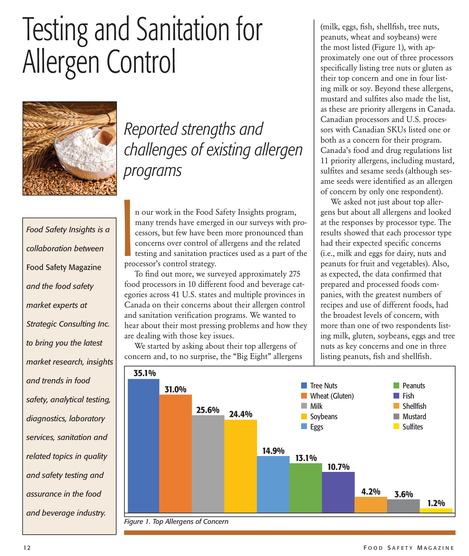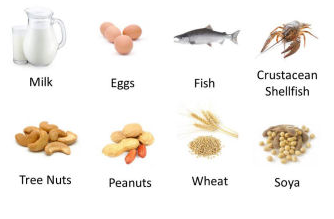Food Allergens
A group of the eight major food allergs is often referred to as the Big-81 and comprises milk, eggs, fish, crustacean shellfish, tree nuts, peanuts, wheat and soybean. These foods account for about 90% of all food allergies in the United States and must be declared on any processed food according to the USA food allergen labeling act (FALCPA)1. In addition labeling of the Big-8 is mandatory according to EU, Canadian, Japanese and Australian / New Zealand regulations, all of which follow Codex Alimentarius recommendations.
Allergic consumers may accidentally encounter problem foods as several of the Big-8 (e.g. eggs, milk, wheat, and soybean) are often used in processed products and can be “hidden”, or not reported on the label. This is the biggest reason for food recalls at present. Food allergens not being reported on the label.
Tyson Foods had to recall 2.5 million pounds of ready to eat breaded chicken because milk was not on the label. This was a fault of an ingredient supplier to Tyson, but they still took the hit.
Food Allergens – Milk
Milk is a frequent cause of allergy worldwide and accounts for the highest occurrence of food allergy in infancy16. Reported prevalence in early childhood ranges between 2-6%, but is outgrown in up to 90% of cases by the age of 6 years and affects few adults17,18,19. While milk allergy is associated with an immune reaction against a specific protein, intolerance to milk may result from a (usually) genetically determined inability to metabolize the milk sugar lactose.
Allergy to milk proteins usually results in a combination of different symptoms often in the gastrointestinal tract, the skin and the airways within the first hour after consumption.
The most problematic milk allergens are the most abundant proteins in milk and include caseins and the whey proteins alpha-lactalbumin and beta-lactoglobulin20. These proteins are also present in milk from other mammalian species and attempts by milk allergic consumers to substitute cows’ milk with that of other animals is often unsuccessful. Because of this, plant-based milk substitutes such as soymilk (although not recommended for infants < 6 months) or hypoallergenic milk preparations (e.g. partially and fully hydrolyzed milk powders) are often used especially for milk allergic infants22. However, the broad usage of cow's milk in a large range of different processed food (e.g. baking goods, instant soups, seasonings, chocolate, and margarine) represents a challenge to milk allergic consumer to avoid.
Food Allergens – Hen Eggs
Hens’ eggs represent a major food allergen source worldwide and are thus included in the Big-8 listing. Eggs are a basic food component, commonly introduced into the diet within the first year of life. A high prevalence of egg allergy is observed especially in children. However, similar to cows’ milk allergy, egg allergy is often outgrown in the first six years of life.
Symptoms of hens’ egg allergy are frequently manifested as reactions of the digestive system. Often the first skin reactions are observed only minutes after consumption, while gastrointestinal symptoms can vary in time of onset, severity and duration25. Anaphylactic and respiratory reactions after ingestion of egg proteins have also been reported.
Major proteins involved in egg allergy are located in the egg white (e.g. ovalbumin, ovomucoid, ovotransferrin, lysozyme), whilst egg yolk proteins appear to trigger allergic reactions infrequently. Most egg white allergens retain their allergenicity after heating. Due to the similarity of the egg proteins in eggs from other bird species (e.g. goose, duck) individuals sensitized to hens’ egg commonly react to eggs of other species. Consumption of poultry meat is usually not problematic28.
Individuals with egg allergy need to avoid typical egg-containing foods and, due to the widespread use of egg in processed foods often have to avoid many baked goods, mayonnaise, some pasta, salad dressings as well as cosmetics and medical products (e.g. hair-care products, anesthetics, vaccines).
Food Allergens – Fish
Whilst fish allergy has been reported all over the world it tends to be more common in regions of high fish consumption. Commonly observed symptoms of allergic reactions to fish are skin and gastrointestinal reactions occurring shortly after ingestion. Occasionally severe systemic reactions including anaphylactic shock are also observed.
Despite the great range of different fish species, most allergic reactions are caused by the fish muscle protein parvalbumin. Individuals with allergic reactions to one fish species, tend to be sensitive to others as well. The fish parasite Anisakis simplex may trigger allergic reactions after consumption of infested fish, even if it is thoroughly cooked30. Occasionally, adverse reactions to fish are observed due to histamine poisoning (scombroid) in decayed fish and may be mistaken for an allergic reaction due to similar symptoms31.
The major fish allergen parvalbumin retains its allergenicity even after heating and as a consequence avoidance of fish containing foods is essential for sensitive individuals. Fish is often present in processed foods such as pizza toppings, garnishes, sauces and soups. Other minor allergens have been identified in fish.
Food Allergens – crustacean shellfish
The group of crustacean shellfish comprises a range of members of which shrimps, prawns, crabs and lobsters are most relevant to human diet. They contribute considerably to human nutrition and the world economy32.
Allergy to crustacean shellfish seems to predominantly affect older children and adults, especially in regions with a high rate of consumption33. Crustacean shellfish allergic individuals regularly react to various different types of crustacean shellfish but can also react to molluscan shellfish and edible land snails, caused by the major shellfish allergen tropomyosin. The widespread occurrence of tropomyosin in other invertebrate species can cause crustacean allergic individuals to also react to non-dietary invertebrates (e.g. house dust mite, cockroach).
Symptoms of crustacean shellfish allergy range from mild local reactions in the oral cavity (oral allergy syndrome) to severe life threatening systemic reactions. Occasionally gastrointestinal and respiratory symptoms occur. Occupational exposure to crustacean shellfish aerosols during processing and food preparation can be associated with rhinitis and conjunctivitis34.
Since shellfish retains its allergenic potential even after heating, avoidance of all forms of shellfish is essential. Crustacean shellfish may be present in some processed instant foods (e.g. pizza, garnishes, sauces, salad dressings).
Food Allergens – Moluscan Shellfish
The molluscan shellfish relevant in human diet are gastropods (including abalones, limpets, land and marine snails, whelks), bivalves (including oysters, mussels, scallops) and cephalopods (including squids, octopuses). Increasingly, molluscan shellfish are recognized as important food allergens and have recently been added to the EU list for mandatory labeling of allergens. The prevalence of molluscan shellfish allergy is largely unknown but may parallel consumption patterns, with higher frequency in areas of frequent consumption.
The major allergen of molluscan shellfish is tropomyosin and thus individuals developing allergic reactions to one mollusc species also often react to other species as well. Due to the similarity between invertebrate tropomyosin allergens molluscan shellfish allergic individuals may also react to crustacean shellfish and non-dietary invertebrates (e.g. house dust mite, cockroach).
Molluscan shellfish allergy triggers symptoms ranging from mild local reactions in the oral cavity (oral allergy syndrome) to severe life threatening systemic reactions. Gastrointestinal and respiratory symptoms were occasionally also reported. Shellfish allergens retain their allergenic potential even after heating.
Food Allergens – Spices and Herbs
A large range of plant derived products are used as spices (e.g. dried seeds, fruits, root, bark) and herbs (e.g. leaves), often varying widely around the world. Although spices and herbs are usually only added in small quantities to add flavor to foods, this may be sufficient to trigger adverse reactions. The most problematic spices for the allergic consumer appear to be celery and mustard. Other allergenic ingredients may be used as a carrier for spice blends.
Some of the allergens in these foods are heat stable (e.g. from celery) and may retain their allergenic potential even after food processing. Others may be heat labile and easily degraded. In any case, many herbs are added freshly after cooking (e.g. parsley, basil, chives) and are not exposed to heating.
Allergy to spices and herbs often involves local reactions in the oral cavity causing itching of the mucosa, swelling of lips and tongue (oral allergy syndrome). Reactions have commonly been reported to anis, celery, coriander, cumin, fennel, parsley, ragweed, Echinacea, artichoke, dandelions and hibiscus.
A few people also have allergic reacions to sufates and sulfides.

